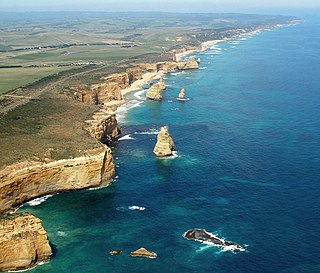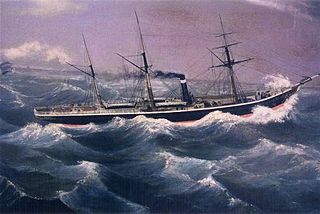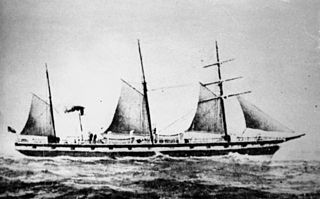This article needs additional citations for verification .(September 2007) |

The Loch Ard Gorge is part of Port Campbell National Park, Victoria, Australia, about three minutes' drive west of The Twelve Apostles.
This article needs additional citations for verification .(September 2007) |

The Loch Ard Gorge is part of Port Campbell National Park, Victoria, Australia, about three minutes' drive west of The Twelve Apostles.
The gorge is named after the clipper Loch Ard that was shipwrecked on 1 June 1878 near the end of a three-month journey from England to Melbourne. Of 54 passengers and crew, only two survived: Thomas Pearce, one of the ship's apprentices; and Eva Carmichael, an Irishwoman emigrating with her family. Pearce and Carmichael were each 19 years old. [1]
According to memorials at the site, Pearce was washed ashore, and rescued Carmichael from the water after hearing her cries for help. Pearce then climbed out of the gorge to raise the alarm to local pastoralists who quickly came to Carmichael's rescue. Three months after the disaster, which claimed the lives of seven members of her family, Carmichael returned to Ireland. Pearce was hailed a hero, and the Victorian Humane Society awarded him its first Gold Medal. He died aged 49 and is buried in Southampton Old Cemetery, England.

At least four of Loch Ard's passengers are buried nearby: Reginald Jones, Arthur Mitchell, Eva Carmichael's elder sister Raby and their mother Rebecca. [2] The bodies of many of the other passengers and crew were never found.
The arch of the nearby Island Archway collapsed in June 2009. The feature now appears as two unconnected rock pillars. [3] They have since been officially named Tom and Eva after the two survivors of the Loch Ard wreck. [4]

The gorge is accessed via the Great Ocean Road, 3.5 kilometres (2 miles) northwest of The Twelve Apostles. Stairs allow visitors access to the beach and a pathway allows access to the eastern side of the gorge. There are numerous plaques and a small museum detailing the site's history, as well as a rest area, and cemetery housing many of the people that died.
The uncommon rufous bristlebird (Dasyornis broadbenti) is often observed around the Gorge. [5]
This was the location for a number of scenes of the 1982 film The Pirate Movie and also the 1999 TV series Journey to the Center of the Earth with Treat Williams. The gorge hosted the final task and finish line for the third series of The Amazing Race Australia . [6]

The Great Ocean Road is an Australian National Heritage-listed 240-kilometre (150 mi) stretch of road along the south-eastern coast of Australia, between the Victorian towns of Torquay and Allansford. Built by returned soldiers between 1919 and 1932, and dedicated to soldiers killed during World War I, the road is the world's largest war memorial. Winding through varying terrain along the coast, and providing access to several prominent landmarks, including the Twelve Apostles limestone stack formations, the road is an important tourist attraction.

The Port Campbell National Park is a national park in the south-western district of Victoria, Australia. The 1,750-hectare (4,300-acre) national park is situated approximately 190 kilometres (120 mi) south-west of Melbourne and approximately 10 kilometres (6.2 mi) east of Warrnambool. The park is located adjacent to the Great Otway National Park and the Bay of Islands Coastal Park.

London Bridge is an offshore natural arch in the Port Campbell National Park, Australia. The arch is a significant tourist attraction along the Great Ocean Road near Port Campbell in Victoria. The stack was formed by a gradual process of erosion, and until 1990 formed a complete double-span natural bridge.

SS Yongala was a passenger steamship that was built in England in 1903 for the Adelaide Steamship Company. She sank in a cyclone off the coast of Queensland in 1911, with the loss of all 122 passengers and crew aboard.

The Gibson Steps are an area of cliffs on the south coast of Australia, located at 38°40′06″S143°06′43″E. The cliffs are the first sightseeing stopoff in Port Campbell National Park for travellers heading West along the Great Ocean Road, located about 2 minutes drive from The Twelve Apostles. The name Gibson Steps refers to the staircase leading down to the stretch of beach shown to the right.

The Shipwreck Coast of Victoria, Australia stretches from Cape Otway to Port Fairy, a distance of approximately 130 km. This coastline is accessible via the Great Ocean Road, and is home to the limestone formations called The Twelve Apostles.

Loch Ard was an iron-hulled clipper ship that was built in Scotland in 1873 and wrecked on the Shipwreck Coast of Victoria, Australia in 1878.

The Grotto is a sinkhole geological formation and tourist attraction, found on the Great Ocean Road outside Port Campbell in Victoria, Australia. Wooden steps wind down the cliff face to the bottom, providing visibility of the sea beyond a pool at low tide.
Cape Otway is a cape and a bounded locality of the Colac Otway Shire in southern Victoria, Australia on the Great Ocean Road; much of the area is enclosed in the Great Otway National Park. The cape marks the boundary between the Southern Ocean on the west and Bass Strait on the east.

The Great Ocean Walk is a walking trail on Victoria's southwest coast in Australia, traversing several areas of historical and cultural significance. The track makes extensive usage of eco-friendly facilities; with Parks Victoria and tour guide operators attempting to raise environmental awareness. The trail meanders along high cliff tops and sandy beaches.

SS Admella was an Australian passenger steamship that was shipwrecked off the coast of the colony of South Australia in 1859. It broke up after striking a submerged reef near Cape Banks, off the coast near Carpenter Rocks, southwest of Mount Gambier, in the early hours on 6 August 1859. Survivors clung to the wreck for over a week and many people took days to die as they glimpsed the land from the sea and watched as one rescue attempt after another failed.

SS Gothenburg was an iron-hulled sail- and steamship that was built in England in 1854 and sailed between England and Sweden until 1862. She then moved to Australia, where she operated across the Tasman Sea to and from New Zealand until 1873, when she was rebuilt. After her rebuild, she operated in the Australian coastal trade.

Loch Vennachar was an iron-hulled, three-masted clipper ship that was built in Scotland in 1875 and lost with all hands off the coast of South Australia in 1905. She spent her entire career with the Glasgow Shipping Company, trading between Britain and Australia. The company was familiarly called the "Loch Line", as all of its ships were named after Scottish lochs. The ship was named after Loch Venachar, in what was then Perthshire.
The Loch Line of Glasgow, Scotland, was a group of colonial clippers managed by Messrs William Aitken and James Lilburn. They plied between the United Kingdom and Australia from 1867 to 1911.

Loch Sloy was a Scottish sailing barque that operated between Great Britain and Australia from the late 19th century until 1899. Her name was drawn from Loch Sloy, a freshwater loch which lies to the north of the Burgh of Helensburgh, in the region of Argyll and Bute, Scotland. Ships Captains: 1877 - 1885 James Horne, 1885 – 1890 John McLean, 1890 – 1895 Charles Lehman, 1895 – 1896 James R. George, 1896 – 1899 William J. Wade, 1899 Peter Nicol.
Princetown is a town in Victoria, Australia, located on the Great Ocean Road, east of the Twelve Apostles, in the Corangamite Shire.
The Royal Humane Society of Australasia (RHSA), formerly the Victorian Humane Society, is an Australian charity dedicated to the recognition of those who risk their own lives in saving or attempting to save the lives of others. It also provides assistance to persons injured as a result of their bravery, or to their next of kin if they perished in the attempt.
Loch Sunart was an iron-hulled sailing ship that was built in Scotland in 1878 for Loch Line's service between Great Britain and Australia. The ship was named after Loch Sunart in Lochaber.
Thomas Richard Pearce (1859–1908), born Thomas Richard Millett, was an Irish ship master in the UK merchant marine. He served his apprenticeship on sailing ships with Aitken & Lilburn's Loch Line, and then rose through the ranks on steamships with the Royal Mail Steam Packet Company (RMSP).

The Island Archway was a 25 meter high, naturally formed rock arch that lay off Loch Ard Gorge, a bay on the south coast of Victoria, Australia. The gate collapsed on 10 June 2009. The arch of rock exposed in the water has been frequently photographed by the numerous international and domestic tourists vacationing in the Great Ocean Road area. The national and international press reported extensively on this geological event.
![]() Media related to Loch Ard Gorge at Wikimedia Commons
Media related to Loch Ard Gorge at Wikimedia Commons
38°38′47.7″S143°04′13.8″E / 38.646583°S 143.070500°E